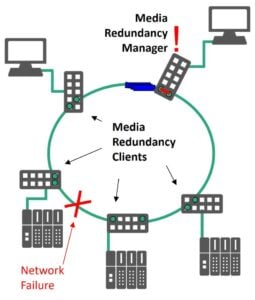High Availability
PROFINET supports high availability, whether in process automation or other applications, with System Redundancy and Media Redundancy. When we talk about system redundancy what we really mean scalable system redundancy because it isn’t just one thing. This is where we add components to the network for increasing the level of system availability – There are 4 possibilities: S1, S2, and R1, R2. The letter indicates if there are Single (S) or Redundant (R) Network Access Points (NAPs), and the number indicates how many Application Relations (ARs) are supported by each NAP (1 or 2).
System Redundancy
Think of a Network Access Point as a physical interface to the network, and think of an Application Relation as a network connection for doing both cyclic and acyclic data exchange between controllers and devices. So, referring to Figure 1, for S1 we can see it has Single NAPs (S) with one Application Relation (1) connected to one Controller. For S2, notice it also has Single NAPs, but with two ARs each connected to different controllers. This helps keep the system running in the event one of the redundant controllers fails because all devices still have a connection to a controller. The concept is the same when we have redundant NAPs. For R1, it has redundant NAPs, meaning each device has two (redundant) physical connections, with one AR for each NAP. These NAPs provide connections to different controllers. For R2, it also has redundant NAPs, but with two ARs for each NAP providing multiple connections to the different controllers.

Network Redundancy
So now you can see how system redundancy supports high availability by increasing system availability using NAPs and ARs. We can also support high availability by using media redundancy. When we talk about media redundancy what we really mean network redundancy. And the way PROFINET supports media (network) redundancy is through the use of ring topologies. The reason we use rings is because if a cable or physical connection breaks, or a device fails, the network can revert back to a line topology – keeping the system operational. However, supporting network redundancy with rings means we can’t use protocols typically used in IT networks like the Spanning Tree Protocol (STP) and Rapid Spanning Tree Protocol (RSTP). This is because STP and RTSP actually prevent network redundancy by blocking redundant paths in order to keep frames from circulating forever in the network.

So in order for PROFINET to support rings, we also need a way to prevent frames from circulating forever in the network. And to do this, we use a protocol called the Media Redundancy Protocol, or MRP. MRP uses one Media Redundancy Manager (MRM) for each ring, and the rest of the devices are called Media Redundancy Clients (MRC) as shown in Figure 2. MRMs are typically controllers or PROFINET switches, and clients are typically devices. The MRM periodically sends test frames to check the integrity of the ring. If the MRM doesn’t get the test frame back, there is a failure somewhere in the ring. The MRM then notifies the MRCs about the failure and sets the network to operate as a line topology until the failure is repaired.
System Redundancy + Network Redundancy
Now we can see how system redundancy and media redundancy support high availability. System redundancy does this by increasing system availability while media redundancy does this by increasing network availability. Obviously, we can use one without the other, but by combining media redundancy and system redundancy, we can increase the overall system reliability. For example, Figure 3 is showing different topologies for S1 and S2. Notice that we can only have media redundancy for S1 since there isn’t a secondary controller to provide system redundancy. For S2, we combine system redundancy and network redundancy by adding an MRP ring, but there are other topologies possible.

Figure 4 shows two topologies for adding media redundancy to R1 and R2. For R1, we add an MRP ring for each redundant NAP. For R2, we also have an MRP ring for each redundant NAP, but we also add a third MRP ring for the controllers. But again, there are lots of topologies possible, depending on the number of ports on each device and the number of switches in the network.

Conclusion
So there you have it. PROFINET supports high availability using system redundancy and network redundancy. These capabilities provide flexibility to match the OT network architecture with system reliability requirements.
